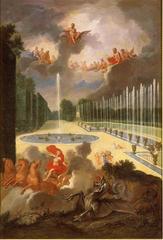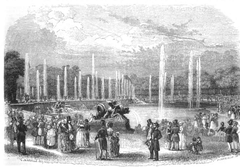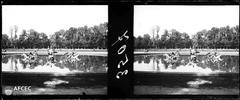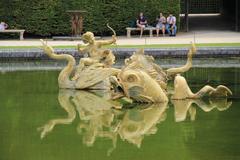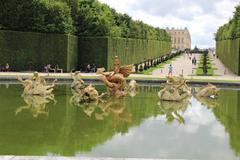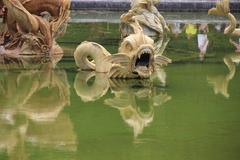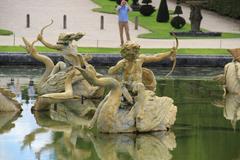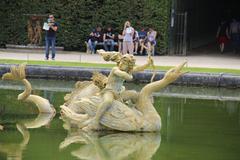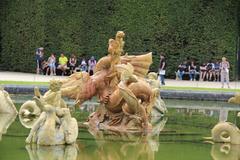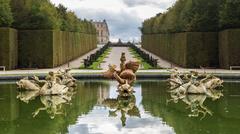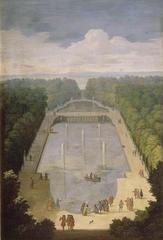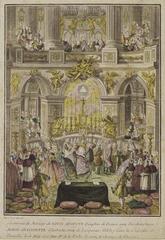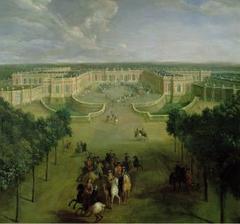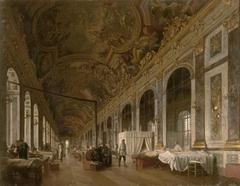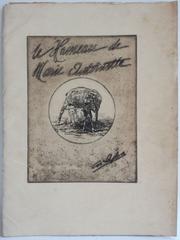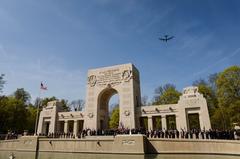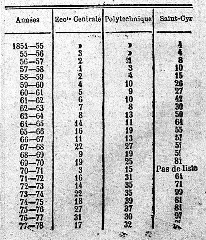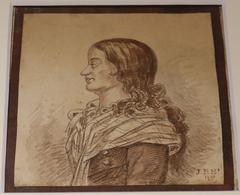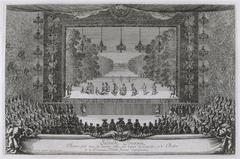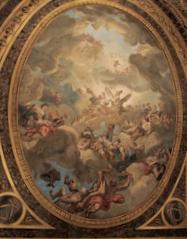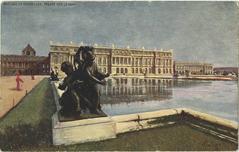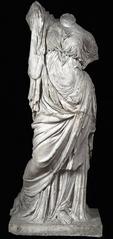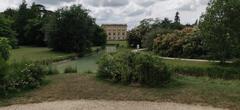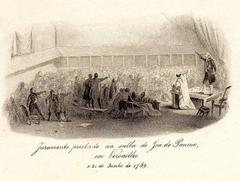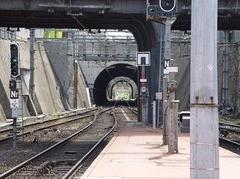
Visiting Hours and Tickets for Dragon Fountain, Versailles
Date: 17/08/2024
Introduction
The Dragon Fountain, nestled within the enchanting gardens of the Palace of Versailles in France, stands as a testament to the grandeur of Baroque garden art and hydraulic engineering. Constructed in 1667 during the reign of King Louis XIV, also known as the Sun King, this magnificent fountain was created by the skilled artist Gaspard Marsy. Positioned strategically at the end of the northern axis between the Water Walk and the Neptune Fountain, the Dragon Fountain is a focal point in the meticulously designed landscape of the Versailles gardens (simple.wikipedia.org). The fountain’s design is steeped in classical mythology, depicting a dramatic scene where the young god Apollo slays the serpent Python with an arrow, surrounded by dolphins and armed Cupids riding swans. This imagery aligns with the broader mythological themes prevalent throughout the gardens, celebrating the divine authority of Louis XIV (chateauversailles.fr). One of the most impressive features of the Dragon Fountain is its hydraulic engineering, boasting a water jet that reaches a towering height of 27 meters, the tallest among all fountains in the Versailles gardens (bienvenue.chateauversailles.fr). These engineering marvels were achievable by turning off other fountains when the King was present, ensuring the Dragon Fountain operated at full capacity (simple.wikipedia.org).
Table of Contents
History of the Dragon Fountain
Origins and Construction
The Dragon Fountain, located at the Palace of Versailles in France, is a remarkable example of Baroque garden art and hydraulic engineering. The fountain was dedicated by Gaspard Marsy in 1667, during the reign of King Louis XIV, also known as the Sun King. The fountain is situated at the end of the northern axis between the Water Walk and the Neptune Fountain, making it a focal point in the grand layout of the Versailles gardens (simple.wikipedia.org).
Mythological Significance
The Dragon Fountain represents an episode from the legend of Apollo, specifically the moment when the young god Apollo kills the serpent Python with an arrow. This mythological scene is depicted with the serpent surrounded by dolphins and Cupids armed with bows and arrows, riding on swans (chateauversailles.fr). The choice of this mythological theme aligns with the broader iconography of the Versailles gardens, which often feature scenes from classical mythology to glorify the reign of Louis XIV.
Hydraulic Engineering Feats
One of the most impressive aspects of the Dragon Fountain is its hydraulic engineering. The main water jet of the fountain reaches a height of 27 meters (approximately 90 feet), making it the tallest among the fountains in the gardens of Versailles (bienvenue.chateauversailles.fr). This feat was achieved by turning off all other fountains in the garden when the King was present, allowing the Dragon Fountain to operate at its full capacity. At other times, the fountain was regulated to a 35-foot jet (simple.wikipedia.org).
Restoration and Reproduction
The central sculptural group of the Dragon Fountain was reproduced in 1889, ensuring that the fountain retained its historical and artistic integrity (chateauversailles.fr). This restoration effort was part of a broader initiative to preserve the artistic and historical heritage of the Versailles gardens, which are considered a masterpiece of French Baroque landscape design.
Artistic Elements
The Dragon Fountain is not just a marvel of engineering but also a work of art. The fountain features statues of children mounted upon swans, adding a playful and dynamic element to the scene. These artistic details contribute to the overall aesthetic of the fountain, making it a captivating sight for visitors (simple.wikipedia.org).
Role in the Grande Perspective
The Dragon Fountain is part of the Grande Perspective, a grand axis that extends from the Palace of Versailles through the gardens to the Grand Canal. This axis is a key element in the overall design of the Versailles gardens, which were laid out by the famous landscape architect André Le Nôtre. The Grande Perspective includes other significant fountains such as the Latona Fountain and the Apollo Fountain, creating a cohesive and visually stunning landscape (worldinparis.com).
Historical Context
The construction of the Dragon Fountain and other elements of the Versailles gardens was part of King Louis XIV’s grand vision to create a palace and garden complex that would symbolize his absolute power and divine right to rule. The gardens were designed to impress and awe visitors, showcasing the wealth, power, and artistic taste of the French monarchy. The Dragon Fountain, with its impressive water jet and mythological theme, played a crucial role in this grand spectacle (european-traveler.com).
Operational Challenges
Maintaining the Dragon Fountain and other fountains at Versailles has always been a technical challenge due to the enormous amount of water required. In the 17th century, various hydraulic systems, including artificial ponds and water mills, were developed to supply water to the fountains. Despite these efforts, water supply remained a recurring problem, and the fountains were often only operated during special occasions or when the King was present (worldinparis.com).
Modern-Day Significance
Today, the Dragon Fountain continues to be a major attraction for visitors to the Palace of Versailles. It is often featured in the Musical Fountains Show (Grandes eaux musicales), where the fountains are synchronized with music to create a spectacular display. These shows take place on weekends and public holidays from April to October, offering visitors a chance to experience the gardens of Versailles at their most magnificent (european-traveler.com).
Visiting Hours and Tickets
For those planning to visit the Dragon Fountain, it is important to note the visiting hours and ticket prices. The fountains generally operate in the afternoons during the Musical Fountains Show, which takes place on weekends and public holidays from April to October. Tickets for the Musical Fountains Show can be purchased online or at the Palace of Versailles, with prices varying depending on the type of ticket and any additional experiences or tours included (wanderingwhytraveler.com).
Travel Tips
Visitors should wear comfortable walking shoes and consider bringing a picnic to enjoy in the gardens, as food and drink options within the gardens can be limited and expensive. Additionally, it is advisable to arrive early to avoid the crowds and to check the weather forecast, as the fountains are best enjoyed on a sunny day (wanderingwhytraveler.com).
Accessibility
The Palace of Versailles and its gardens strive to be accessible to all visitors. The Dragon Fountain area is relatively flat and can be accessed by wheelchair users. However, the gravel paths and uneven terrain in some parts of the gardens may pose challenges. Visitors with mobility issues are encouraged to check the official Palace of Versailles website for detailed accessibility information and to plan their visit accordingly (chateauversailles.fr).
FAQ
Q: What are the visiting hours for the Dragon Fountain? A: The Dragon Fountain is typically in operation during the Musical Fountains Show, which takes place on weekends and public holidays from April to October, generally in the afternoons.
Q: How much do tickets cost for the Musical Fountains Show? A: Ticket prices vary depending on the type of ticket and any additional experiences or tours included. It is best to check the official Palace of Versailles website for the most up-to-date information.
Q: Is the Dragon Fountain accessible to visitors with disabilities? A: The area around the Dragon Fountain is relatively flat and can be accessed by wheelchair users, though some parts of the gardens may be challenging due to gravel paths and uneven terrain.
Q: Are there food and drink options available in the gardens? A: Food and drink options within the gardens are limited and can be expensive. Visitors are encouraged to bring a picnic to enjoy in the gardens.
Conclusion
The Dragon Fountain at the Palace of Versailles is a remarkable blend of art, mythology, and engineering, making it an essential attraction for visitors. Its historical significance, impressive water jet, and artistic details contribute to its enduring allure. The fountain’s mythological symbolism, engineering feats, and role in the grand design of the Versailles gardens reflect the opulence and power of King Louis XIV’s reign. Today, the Dragon Fountain continues to captivate visitors, particularly during the Musical Fountains Show, where its synchronized water displays with music create a mesmerizing spectacle (european-traveler.com). Practical tips such as visiting during show times, purchasing tickets in advance, and wearing comfortable footwear enhance the visitor experience. Accessibility efforts ensure that all visitors can appreciate this historical marvel. By following these guidelines, visitors can fully immerse themselves in the grandeur of the Versailles gardens and the timeless beauty of the Dragon Fountain (wanderingwhytraveler.com).
References
- Simple Wikipedia. (n.d.). Dragon Fountain. source
- Château de Versailles. (n.d.). Fountains. source
- Bienvenue au Château de Versailles. (n.d.). Dragon Fountain. source
- European Traveler. (n.d.). Tips on Visiting the Musical Fountain Show at the Palace of Versailles. source
- Wandering Why Traveler. (2019). 12 Pro Tips for Visiting Versailles. source
